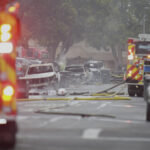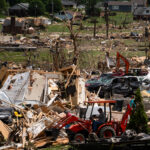The Government Accountability Office is recommending tougher oversight of safety at the nation’s federal nuclear weapons laboratories, contending there have been persistent safety problems in recent years, including nearly 60 serious accidents or near misses since 2000.
Republican Reps. Joe Barton of Texas and Ed Whitfield of Kentucky asked for a report 18 months ago after security breaches and safety concerns at northern New Mexico’s Los Alamos National Laboratory. The GAO also reviewed Albuquerque-based Sandia National Laboratories and Lawrence Livermore National Laboratory in California.
The GAO report released Wednesday blamed a lax attitude toward safety procedures, weaknesses in identifying safety problems and then correcting them; and inadequate oversight by site offices of the National Nuclear Security Administration, a Department of Energy division that oversees the labs.
The GAO recommended the NNSA retain independent federal oversight and ensure that efforts to improve safety be measured by the outcome, not the process. It also recommended annual progress reports to Congress.
John Broehm, an NNSA spokesman in Washington, D.C., said agency officials generally agreed with the recommendations, but felt the report “was a little misleading” in its implication that the labs have major problems.
“A lot of it is worker safety vs. nuclear safety,” he said.
“We take nuclear safety and worker safety very seriously. But when you look at the size and scope of what we do, we feel the numbers are pretty good,” Broehm said.
A spokesman for Los Alamos, Kevin Roark, said the lab showed significant safety and security improvements in fiscal 2007, reducing the number of incidents and injuries by 30 percent.
“We feel that we’ve come a long way toward changing the safety culture at the lab, but we realize there’s always room for improvement,” he said.
The GAO said it found little indication that the NNSA or contractors that manage the labs had followed a 2003 directive calling for a disciplined approach toward improvements. The report also criticized the NNSA’s heavy reliance on contractors’ own safety management controls for oversight.
It noted the agency was strengthening oversight and taking other steps, but said those efforts were still under way and it was too early to see what effect they might have.
Accidents and nuclear safety violations contributed to temporary shutdowns at both Los Alamos and Lawrence Livermore in 2004 and 2005, but safety problems persist, the report said.
Los Alamos shut down virtually all its divisions for review in the summer of 2004 after two computer disks believed to contain classified information were reported missing and an intern suffered an eye injury from a laser. The lab wasn’t back into full operation until early 2005.
Accidents at the labs included workers being exposed to radiation, inhaling toxic vapors and being shocked. The GAO said no one was killed but that some workers were seriously injured and lab facilities were damaged.
Among incidents cited:
-A 2000 accident in which seven workers at a Los Alamos plutonium-processing facility received “significant doses of radiation” because the lab failed to correct problems after previous incidents.
-Los Alamos and Lawrence Livermore being found in violation of safety rules eight times since 2000, with penalties totaling nearly $3 million for Los Alamos and $808,000 for Lawrence Livermore. Sandia has not been cited for a safety violation since before 2000.
-A 2002 incident in which liquid chlorine dioxide formed during an experiment at Los Alamos and exploded. The experiment’s two researchers noticed a rapid rise in temperature and fled the room seconds before the explosion.
-A 2003 accident at a Sandia construction site that seriously injured two workers.
-A 2005 incident in which a Los Alamos worker opened a package containing radioactive material and unknowingly contaminated himself, his clothing and items he touched. The contamination was not discovered for 11 days and in the meantime, the worker spread it to his home, other places in Los Alamos and relatives’ homes in Colorado and Kansas.
Was this article valuable?
Here are more articles you may enjoy.

 Plane Crashes into San Diego Neighborhood, Setting Homes And Vehicles on Fire
Plane Crashes into San Diego Neighborhood, Setting Homes And Vehicles on Fire  Report Shows Cargo Theft Risk at All-Time Highs as Memorial Day Weekend Nears
Report Shows Cargo Theft Risk at All-Time Highs as Memorial Day Weekend Nears  We Have Entered A New Era of Auto Claims Complexity
We Have Entered A New Era of Auto Claims Complexity  Trump Administration Targets Resiliency Funds to Shrink FEMA’s Role
Trump Administration Targets Resiliency Funds to Shrink FEMA’s Role 